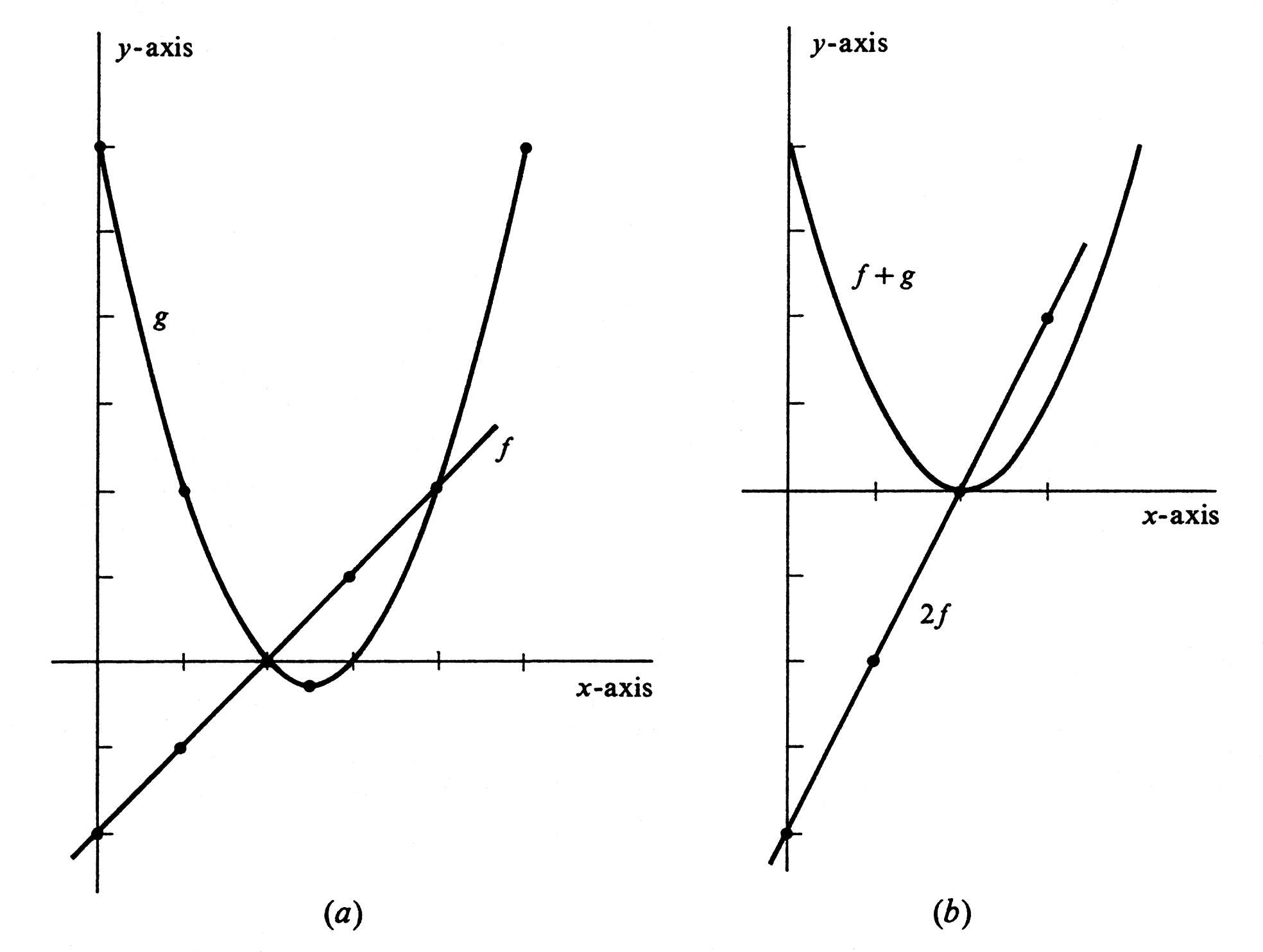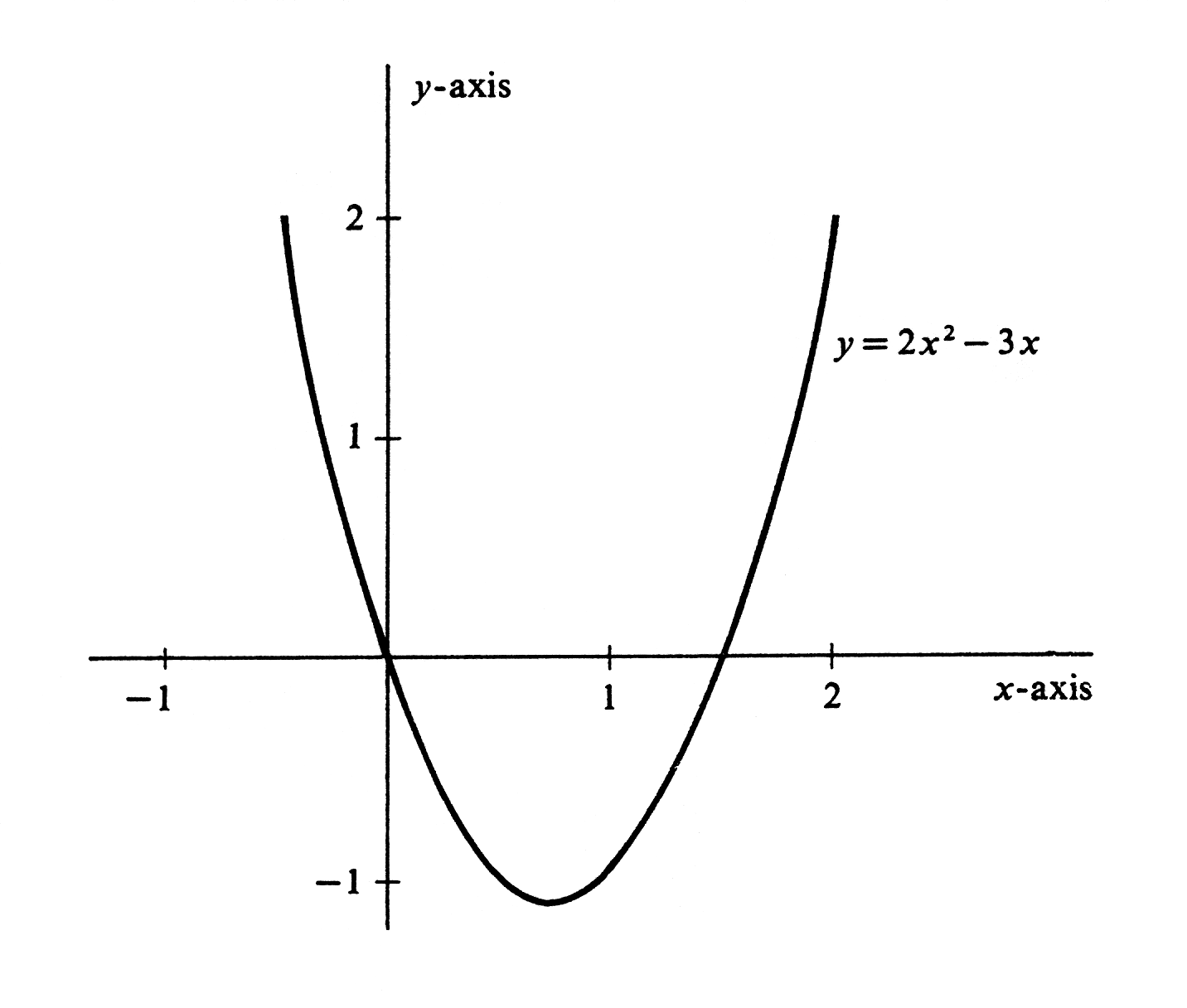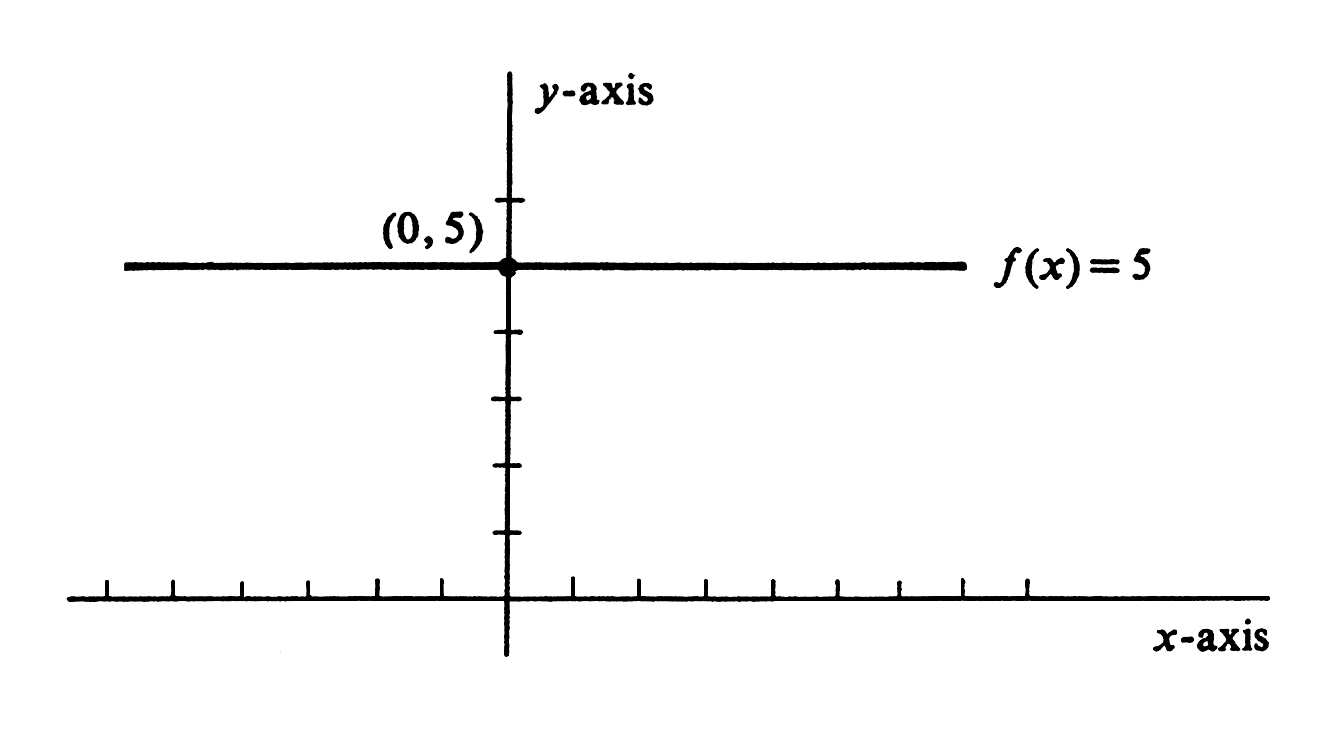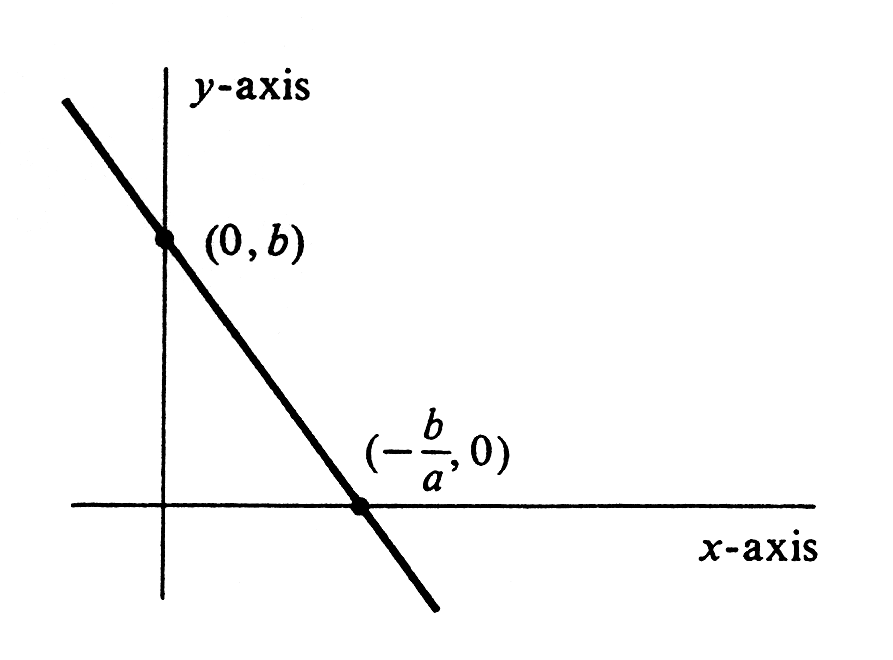guide:D0085fde68: Difference between revisions
No edit summary |
mNo edit summary |
||
| Line 33: | Line 33: | ||
</math></div> | </math></div> | ||
If <math>f</math> and <math>g</math> are two functions, | If <math>f</math> and <math>g</math> are two functions, | ||
a new function <math>f(g)</math>, | a new function <math>f(g)</math>, | ||
| Line 153: | Line 152: | ||
We compute the function values | We compute the function values | ||
corresponding to several different numbers <math>x</math> in | corresponding to several different numbers <math>x</math> in | ||
[[#table 1.3 | | [[#table 1.3 |table]] and [[#table 1.4 |table]]. | ||
The resulting graphs of <math>f</math> and <math>g</math> are, respectively, | The resulting graphs of <math>f</math> and <math>g</math> are, respectively, | ||
the straight line and parabola shown in [[#fig 1.18|Figure]](a). | the straight line and parabola shown in [[#fig 1.18|Figure]](a). | ||
| Line 161: | Line 160: | ||
It turns out that the graphs of <math>2f</math> and <math>f + g</math> | It turns out that the graphs of <math>2f</math> and <math>f + g</math> | ||
are also a straight line and a parabola. | are also a straight line and a parabola. | ||
They are drawn in [[#fig 1.18|Figure | They are drawn in [[#fig 1.18|Figure(b)]]. | ||
To see why the graph of <math>f + g</math> is a parabola, | To see why the graph of <math>f + g</math> is a parabola, | ||
observe that | observe that | ||
| Line 180: | Line 179: | ||
except that it will be shifted two units to the right. | except that it will be shifted two units to the right. | ||
<span id="table 1.3"/> | |||
<math display="block"> | <math display="block"> | ||
\begin{array}{r|r|c} | \begin{array}{r|r|c} | ||
| Line 194: | Line 192: | ||
\end{array} | \end{array} | ||
</math> | </math> | ||
<span id="table 1.4"/> | |||
<math display="block"> | <math display="block"> | ||
\begin{array}{r|c} | \begin{array}{r|c} | ||
| Line 213: | Line 208: | ||
\end{array} | \end{array} | ||
</math> | </math> | ||
Up to this point | |||
we have used the letters | Up to this point we have used the letters | ||
<math>f</math>, <math>g</math>, <math>h</math>, <math>F</math>, <math>G</math>, and <math>H</math> | <math>f</math>, <math>g</math>, <math>h</math>, <math>F</math>, <math>G</math>, and <math>H</math> | ||
to denote functions, | to denote functions,and the letters <math>x</math>, <math>y</math>, <math>a</math>, <math>b</math>, and <math>c</math> | ||
and the letters <math>x</math>, <math>y</math>, <math>a</math>, <math>b</math>, and <math>c</math> | to denote elements of sets---usually real numbers. However, the letters in the second set | ||
to denote elements of sets---usually real numbers. | |||
However, the letters in the second set | |||
are sometimes also used as functions. | are sometimes also used as functions. | ||
This occurs, for example, | This occurs, for example, | ||
| Line 308: | Line 301: | ||
On the one hand, | On the one hand, | ||
we may consider the subset of <math>\R^2</math>, pictured in | we may consider the subset of <math>\R^2</math>, pictured in | ||
[[#fig 1.19 | | [[#fig 1.19 |Figure]], | ||
<div id="fig 1.19" class="d-flex justify-content-center"> | <div id="fig 1.19" class="d-flex justify-content-center"> | ||
[[File:guide_c5467_scanfig1_19.png | 400px | thumb | ]] | [[File:guide_c5467_scanfig1_19.png | 400px | thumb | ]] | ||
| Line 410: | Line 403: | ||
and the identity function <math>x</math>. | and the identity function <math>x</math>. | ||
==General references== | ==General references== | ||
{{cite web |title=Crowell and Slesnick’s Calculus with Analytic Geometry|url=https://math.dartmouth.edu/~doyle/docs/calc/calc.pdf |last=Doyle |first=Peter G.|date=2008 |access-date=Oct 29, 2024}} | {{cite web |title=Crowell and Slesnick’s Calculus with Analytic Geometry|url=https://math.dartmouth.edu/~doyle/docs/calc/calc.pdf |last=Doyle |first=Peter G.|date=2008 |access-date=Oct 29, 2024}} | ||
Revision as of 23:28, 3 November 2024
If [math]f[/math] and [math]g[/math] are two functions, a new function [math]f(g)[/math], called the composition of [math]g[/math] with [math]f[/math], is defined by
For example, if [math]f(x) = x^3 - 1[/math] and [math]g(x) = \frac{x + 1}{x - 1}[/math], then
The composition of two functions is the function obtained by applying one after the other. If [math]f[/math] and [math]g[/math] are regarded as computing machines, then [math]f(g)[/math] is the composite machine constructed by feeding the output of [math]g[/math] into the input of [math]f[/math] as indicated in Figure.
In general it is not true that [math]f(g) = g(f)[/math]. In the above example we have
and the two functions are certainly not the same. In terms of ordered pairs the composition [math]f(g)[/math] of [math]g[/math] with [math]f[/math] is formally defined to be the set of all ordered pairs [math](a, c)[/math] for which there is an element [math]b[/math] such that [math]b = g(a)[/math] and [math]c = f(b)[/math]. If [math]f[/math] and [math]g[/math] are two real-valued functions, we can perform the usual arithmetic operations of addition, subtraction, multiplication, and division. Thus for the functions [math]f(x) = x^3 - 1[/math] and [math]g(x) = \frac{x + 1}{x - 1}[/math], we have
Just as with the composition of two functions, each arithmetic operation provides a method of constructing a new function from the two given functions [math]f[/math] and [math]g[/math]. The natural notations for these new functions are [math]f + g[/math], [math]f - g[/math], [math]fg[/math], and [math]\frac{f}{g}[/math]. They are defined by the formulas
The product function [math]fg[/math] should not be confused with the composite function [math]f(g)[/math]. For example, if [math]f(x) = x^5[/math] and [math]g(x) = x^3[/math], then we have [math](fg)(x) = f(x)g(x) = {x^5} \cdot {x^3} = x^8[/math], whereas
We may also form the product [math]af[/math] of an arbitrary real number [math]a[/math] and real-valued function [math]f[/math]. The product function is defined by
Example \label{exam 1.3.1} Let functions [math]f[/math] and [math]g[/math] be defined by [math]f(x) = x - 2[/math] and [math]g(x) = x^2 - 5x + 6[/math]. Draw the graphs of [math]f[/math], [math]g[/math], [math]2f[/math], and [math]f + g[/math]. We compute the function values corresponding to several different numbers [math]x[/math] in table and table. The resulting graphs of [math]f[/math] and [math]g[/math] are, respectively, the straight line and parabola shown in Figure(a).
It turns out that the graphs of [math]2f[/math] and [math]f + g[/math] are also a straight line and a parabola. They are drawn in Figure(b). To see why the graph of [math]f + g[/math] is a parabola, observe that
It follows that [math]f + g[/math] is very much like the function defined by [math]y = x^2[/math]. Instead of simply squaring a number, [math]f + g[/math] first subtracts [math]2[/math] and then squares. Its graph will be just like that of [math]y = x^2[/math] except that it will be shifted two units to the right.
Up to this point we have used the letters
[math]f[/math], [math]g[/math], [math]h[/math], [math]F[/math], [math]G[/math], and [math]H[/math]
to denote functions,and the letters [math]x[/math], [math]y[/math], [math]a[/math], [math]b[/math], and [math]c[/math]
to denote elements of sets---usually real numbers. However, the letters in the second set
are sometimes also used as functions.
This occurs, for example,
when we speak of [math]x[/math] as a real variable.
As such, it not only is the name of a real number
but also can take on many different values:
[math]5[/math], or [math]-7[/math], or [math]\pi[/math], or \ldots.
Thus the variable [math]x[/math] is a function.
Specifically, it is the very simple function
that assigns the value [math]5[/math] to the number [math]5[/math],
the value [math]-7[/math] to the number [math]-7[/math],
the value [math]\pi[/math] to [math]\pi[/math], \ldots.
For every real number [math]a[/math], we have
This function is called the identity function. Suppose, for example, that [math]s[/math] is used to denote the distance that a stone falling freely in space has fallen. The value of [math]s[/math] increases as the stone falls and depends on the length of time [math]t[/math] that it has fallen according to the equation [math]s= {\frac{1}{2}}g{t^2}[/math], where [math]g[/math] is the constant gravitational acceleration. (This formula assumes no air resistance, that the stone was at rest at time [math]t = 0[/math], and that distance is measured from the starting point.) Thus [math]s[/math] has the value [math]{\frac{9}{2}}g[/math] if [math]t[/math] has the value [math]3[/math], and, more generally, the value [math]{\frac{1}{2}}g{a^2}[/math] when [math]t[/math] has the value [math]a[/math]. If we consider [math]t[/math] to be another name for the identity function, then [math]s[/math] may be regarded as the function whose value is
for every real number [math]a[/math]. The original equation [math]s = {\frac{1}{2}}g{t^2}[/math] then states the relation between the two functions [math]s[/math] and [math]t[/math]. The fact that [math]s[/math] and [math]t[/math] take on different values is also expressed by referring to them as variables. A variable is simply a name of a function. In our example [math]s[/math] is called a dependent variable, and [math]t[/math] an independent variable, because the values of [math]s[/math] depend on those of [math]t[/math] according to [math]s = {\frac{1}{2}}g{t^2}[/math]. Thus an independent variable is a name for the identity function, and a dependent variable is one that is not independent. A real variable is therefore a name of a real-valued function. Since the arithmetic operations of addition, subtraction, multiplication, and division have been defined for real-valued functions, they are automatically defined for real variables. We shall generally use the letter [math]x[/math] to denote an independent variable. This raises the question: How does one tell whether an occurrence of [math]x[/math] denotes a real number or the identity function? The answer is that the notation alone does not tell, but the context and the reader's understanding should. However, a more practical reply is that it doesn't really make much difference. We may regard [math]f(x)[/math] as either the value of the function [math]f[/math] at the number [math]x[/math] or as the composition of [math]f[/math] with the variable [math]x[/math]. If [math]x[/math] is an independent variable, the function [math]f(x)[/math] is then the same thing as [math]f[/math].
Example \label{exam 1.3.2} The conventions that we have adopted concerning the use of variables give our notations a flexibility that is both consistent and extremely useful. Consider, for example, the equationthat consists of all ordered pairs [math](x, y)[/math] such that [math]y = 2x^2 - 3x[/math]. This subset is a function [math]f[/math] whose value at an arbitrary real number [math]x[/math] is the real number [math]f(x) = 2x^2 - 3x[/math]. Alternatively, we may regard [math]x[/math] as an independent variable, i.e., the identity function. The composition of [math]f[/math] with [math]x[/math] is then the function [math]f(x) = 2x^2 - 3x[/math], whose value at [math]2[/math], for instance, is
Example \label{exam 1.3.3} Let [math]F[/math] be the function defined by [math]F(x) = x^3 + x + 1[/math]. If [math]u = \sqrt{x - 2}[/math], then
To say that [math]a[/math] is a real constant
means first that it is a real number.
Second, it may or may not matter which real number [math]a[/math] is,
but it is fixed for the duration of the discussion in which it occurs.
Similarly, a constant function is one which takes on just one value;
i.e., its range consists of a single element.
For example, consider the constant function [math]f[/math] defined by
We shall commonly use lower-case letters at the beginning of the alphabet, e.g., [math]a[/math], [math]b[/math], [math]c[/math],..., to denote both constants and constant functions. Example \label{exam 1.3.4} Consider the function [math]ax + b[/math], where [math]a[/math] and [math]b[/math] are constants, [math]a \neq 0[/math], and [math]x[/math] is an independent variable. The graph of this function is a straight line that cuts the [math]y[/math]-axis at [math]b[/math] and the [math]x[/math]-axis at [math]-\frac{b}{a}[/math]. It is drawn in Figure.
This function is the sum of the constant function [math]b[/math] and the function which is the product of the constant function [math]a[/math] and the identity function [math]x[/math].
General references
Doyle, Peter G. (2008). "Crowell and Slesnick's Calculus with Analytic Geometry" (PDF). Retrieved Oct 29, 2024.




